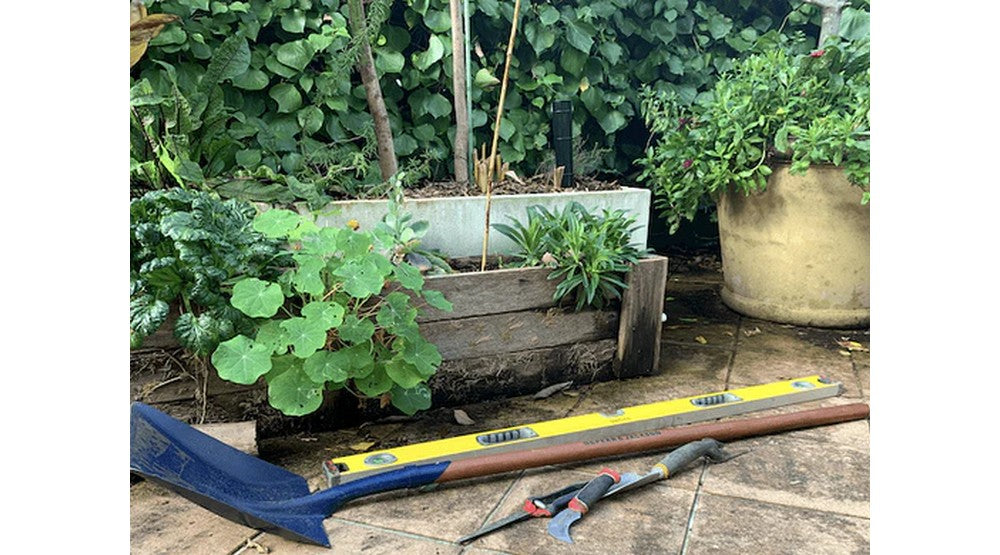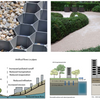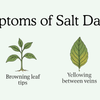Essential Tools for Wicking Beds and Gardening

Posted on: 27 May 2020 by Emmy King
Building wicking beds may require a couple of extra tools, such as a drill and a spirit level. However, even when picking up gardening for the first time, the cost, storage, and sheer number of tools and infrastructure you think you need can be overwhelming.
Walking into a large garden centre can have you feeling like you need gadgets galore. I prefer to look towards permaculture ethics to guide my tool decisions. Part of the permaculture principles is to produce no waste, which means looking towards items that are abundant and freely available. Reusing or recycling where possible, or buying wisely and taking care of these products are important. Starting a garden will require you to have a few key items. Some of them are worth buying new, but remember to start with what you need and grow from there.
Wicking bed set up tools
Wicking beds are fantastic because they reduce the amount of irrigation infrastructure you will need. Trust me, how much you fall in love with gardening will be absolutely be influenced by how easy your irrigation system is to use. Using WaterUps® cells, you will only need to water your established garden every 3-4 weeks. This is because it holds much more water than other types of wicking systems such as scoria or river sand and doesn’t allow water to evaporate or leech from the soil. This ensures that this precious resource is not wasted. There is no comparison with above ground methods of watering, which in summer can become almost a daily occurrence. WaterUps® cells are also made out of recycled plastic, harmonising with the ‘produce no waste’ principle.
One thing you will need to get your hands on is a power drill, but this is something to borrow as you will only need it once. You will need this create the hole in the side of your wicking bed for the overflow pipe, which is essential for maintaining soil health. Without it you wouldn’t know when your reservoir is full and your soil will very likely become anaerobic. Depending on where you are installing your wicking bed you may also need to borrow a spirit level. This is to ensure that, when you install the bed, the base is completely level.
Insect netting
Pests are one of the biggest problems when wanting to obtain a yield using organic and regenerative methods. If you live in NSW or Victoria it is likely that cabbage moth and fruit flies have become your nemesis. In the long term, building healthy soil and creating a diverse ecosystem will reduce the number of things that want to eat your food. In the short term, good quality insect netting can act as an important exclusion barrier. I have experimented with lace curtains before, but as they are not UV stable, they quickly break down in the garden, becoming ineffective and precipitating microplastic into your soil. Depending on the size of your garden, offcuts of high-quality netting can be found on ebay or gumtree from suppliers of big farms. Otherwise, chat to your neighbours and see if you can buy in bulk to distribute among you all. Make sure you look after these nets, but you can easily sew up holes in your nets using nylon string and darning techniques.
Buckets and containers
These are the most underrated tools of the garden. You can pick up 10-20L buckets from most hospitality businesses who are happy to see them put to use (you could also offer to take their food scraps or coffee grounds for your compost too!). These are fantastic for hauling compost and tools, washing crops in, capturing worm juice, and you’ll be surprised what else. To increase the longevity of these useful items, make sure you keep them out of the sun when not in use. Buckets and containers can also be easily modified as wicking beds using WaterUps wicking cells. This is a good option for renters, balcony gardeners, and small spaces where chasing the sunlight is necessary.
A harvest knife
A sharp, well looked after knife is a vital tool in the garden. A lot of gardeners I know swear by folding Opinel knives, but I have a huge affinity for brightly coloured serrated knives such as these Victorinox ones, usually available for under $10. From experience- steer clear of green, black and brown handles, unless you want to lose them in the garden forever!
A long handled spade and/or shovel
Long handled equipment is ergonomic and easy to use, and you will use a spade to clear pathways, dig holes, and move soil around. You can often find these second hand in op shops or garage sales and with a bit of love are perfect. To look after your spade, keep it clean and rust free by using wire wool or a brush. To keep the handle from splitting rub veggie oil (often available from the tip) on it, or polish the wood using a mixture of wax (old candles, beeswax, or even old surfboard wax from your board will work) and veggie oil. The wax helps with water resistance and grip. Keeping the blade of the spade sharp will also make it much more enjoyable to use.
A garden fork
These can range in size for your garden space from a small hand held fork to your classic garden fork to a large scale broadfork. Whatever your context, these tools are invaluable for gently aerating and decompacting your soil, making it nice and friable for your baby plants or seeds.
Garden stakes
When growing climbing plants like tomatoes or beans, or to keep insect netting off crops, garden stakes are invaluable. Bamboo or bana grass are strong and have worked well for me in the past and seem to always be available in my community. Permaculture expert Kat Lavers says her bamboo stakes last 6-7 years, and also recommends prunings from trees and star pickets for when you start to become a tomato master, as fruit laden plants can be very heavy.
Secateurs
These are worth buying new and buying quality, especially if you are maintaining fruit trees or larger crops like eggplants. Many now come with replaceable parts, and ones that fit your hand will reduce repetitive strain injuries. Look after your secateurs by keeping them clean with a wire brush, spraying metholated spirits on the blade to reduce the transmission of disease between trees, and keeping them lubricated. Keeping the blade sharp will make them most effective and safe to use.
String and tree tie
These invaluable tools will help you tie up plants to your stakes or train plants like beans along a fence line. Natural fibres such as jute, hemp, and raffia will all break down in the garden so it doesn’t mater if they get lost. Old stretchy t-shirts can be cut up as tree tie. I have even cut up an old bicycle tire to make strips that acted as perfect tomato ties.
Labels for seedlings
Anyone who has grown seedlings before knows the importance of keeping track of what you have planted and when. Another life changing tip I learnt from Kat was to cut aluminium venetian blinds (found in hard rubbish) into strips to use as seed raising labels. These will last for years and the marker doesn’t rub off as quickly as it seems to on plastic.
Jars to hold seed, large stainless-steel bowls for harvesting, and a spray bottle for liquid fertilisers (eg. worm juice or Seasol) should also be considered but depending on the scale of your garden this list could go on and on. Hoes, weeders, seeders, and wheelbarrows were also essential items for me while running a market garden but I have not found a use for them in my small terrace garden now.
There are lots of other ways to be creative and waste free in your garden. Cloches to keep seedlings warm and protected can be made from plastic soda bottles, greenhouses can be made from salvaged windows, and seed trays from strawberry punnets. Op shops, garage sales and Gumtree are fantastic ways to get your hands-on useful items but think outside the box too. My local community has a ‘good karma network’ on Facebook, where I often trade silverbeet for lemons and have attained a wheelbarrow and countless useful pots. Supporting your local nursery or hardware store is also a fantastic way we can create resilient communities, rather than jumping straight to the big guys, and will often come with advice specific to your locality.
Collecting tools and infrastructure shouldn’t prevent you from gardening, nor should they impact on your earth care ethics. We’d love to hear about your experience of gathering your favourite tools and what you would most recommend to new gardeners!
Send us a pic of your favourite tool to info@waterups.com.au to share on our social media and tell us why you love it or why you’d recommend. To help you on your gardening journey, we’ll give 3 x $50 WaterUps® vouchers for the best answers as chosen by Emmy. Entries close 12.00 noon - 15 June 2020
Links for tools:
https://greenharvest.com.au/tools/index_tool.html
https://www.diggers.com.au/shop/garden-supplies/garden-tools/
https://www.netprocanopies.com/index.php/retailoptions/








